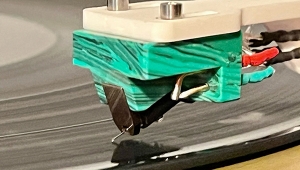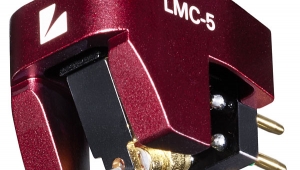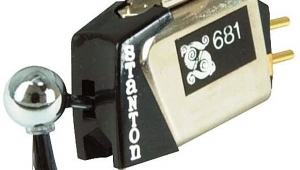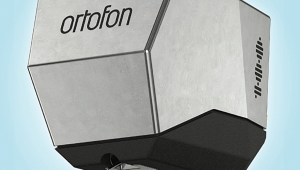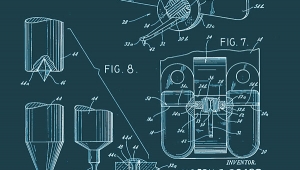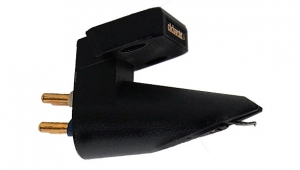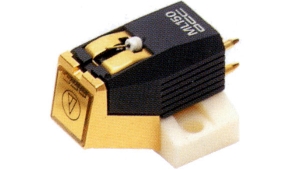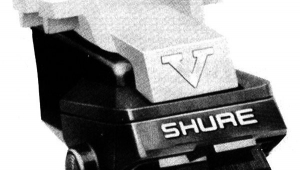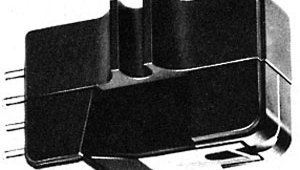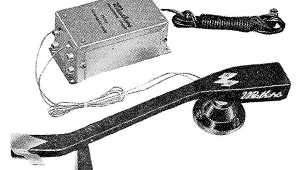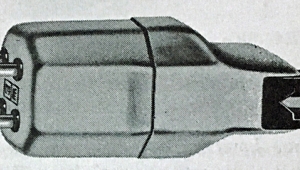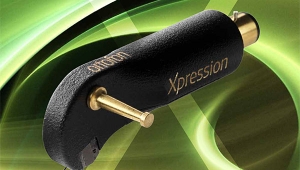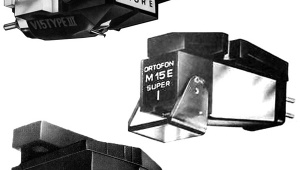| Columns Retired Columns & Blogs |
Soundsmith SMMC1 moving-iron phono cartridge Page 2
The SMMC1's one-piece cantilever is made of ruby to which is attached a nude line-contact diamond stylus with a tip of very low effective mass (0.32mg). The compliance, 28µm/mN, is moderate to high. The SMMC1's frequency response is cited as 20Hz–20kHz, ±2.5dB, while its channel separation at 1kHz is greater than 25dB and its channel matching within 1.6dB or better. (The Voice's channel balance is specced at better than 0.5dB.) The recommended resistive loading is 47k ohms, while the recommended capacitive loading is equal to or greater than 400pF, including the capacitance of the tonearm cable. Soundsmith recommends a tracking force of 1gm.
Though the SMMC1 is intended for use with an MM phono preamp, its specified output is a relatively moderate >2.12mV at 5cm/s. (A typical MM cartridge's output is 4.5mV.) And while the cartridge itself weighs only 1.6gm, the addition of Soundsmith's universal mounting adapter of clear plastic brings the total to about 6.8gm.
Building the SMMC1
A get-acquainted visit to Soundsmith late last summer turned into a hands-on tutorial when Ledermann sprang a surprise: Would I like to build my own cartridge?
Of course! Under the expert supervision of a veteran Soundsmith cartridge builder, I learned to cold-weld, though he told me the chances were slim that I'd be able to actually accomplish the mini-welds needed to secure the ends of the coil wires—which must be done while viewing one's progress through a microscope. But I managed it.

The next step was to carefully and evenly slide the moving-iron assembly's plastic frame (its four tiny holes are produced during the molding) onto the locating rods that jut from the coil/magnet housing, and stop it the correct distance from the coils—before the instant-set glue hardened. That took more than a few attempts, but eventually I got it right. Ledermann then took the assembly to his workstation and installed the cantilever and stylus assembly into the moving iron's tiny tube.
Installation and Optimization
Installing the SMMC1 requires a bit of extra care—there's no stylus guard, though if you're worried about damaging the cantilever, you can unplug the cartridge from the adapter and install just the adapter (which is not tapped, but secured with tiny nuts). The plug-in ability also means you can switch between the various SMMC models in seconds (like inserting the least expensive when you want to teach your kids to spin vinyl), or remove it entirely for visits of the Dreaded Cantilever-Snapping Cleaning Person.
Because the SMMC1 is relatively lightweight, has a high compliance, a lower output than most MM cartridges, and requires a low tracking force, it straddles a number of analog fences, both electrical and mechanical. The MMC series was originally designed for B&O's low-mass tonearms. With the trend in recent years toward low-compliance, heavy-tracking cartridges and matching tonearms of medium to high mass, I was concerned about the SMMC1's compatibility with the Graham Phantom and other medium-mass arms, and with the 40dB gain typical of most MM phono preamps.
The SMMC1's low output definitely means you'll be setting the volume somewhat higher than you may be accustomed to for an MM cartridge with a typical 4.5mV output. This didn't turn out to be a problem with the SMMC1 and the variety of quiet phono preamps I tried, which included Whest Audio's whestTWO (currently under review), the Graham Slee Era Gold V, and the excellent if underappreciated Camelot Technology Lancelot Pro. However, if your phono preamp is noisy, consider that before choosing the SMMC1 or any MMC cartridge.
The Graham Phantom tonearm's 11–12gm of effective mass, plus the SMMC1's approximately 6.8gm, added up to about 17gm. For that effective mass and a compliance of 28µm/mN, Wally Malewicz's graph of tonearm resonances (see "Analog Corner," October 2007, p.31) suggests a resonant frequency of about 7Hz, which is just below the margin of acceptability (8–12Hz). The Hi-Fi News Test Record's excellent tracks of vertical and horizontal resonant frequency confirmed that number. This suggests that if your arm's effective mass is above 11–12gm, and especially if it doesn't offer damping, the SMMC1 might not be a good match.

That said, although 7Hz is not ideal, the SMMC1 performed extremely well in the Phantom, in part because of that arm's excellent silicone-fluid damping system. While some users don't use damping fluid with their Phantoms, I recommend it for a lightweight, high-compliance cartridge such as the SMMC1.
I also found Soundsmith's recommended capacitive loading of 400pF or greater to be accurate. In fact, I preferred the SMMC1's high-frequency balance with 350pF added to the Hovland MusicGroove2 cable's capacitance of 261pF/m (for a total of 611pF). While these settings will be, to some degree, a personal preference as well as system-dependent, be sure to at least know what your phono preamp's default capacitive-loading setting is—or, if it's adjustable, what your options are.
Soundsmith's channel-separation spec of >25dB at 1kHz proved extremely conservative. I measured 36dB—possibly the greatest channel separation I've measured for any cartridge. However, the stated channel balance of <1.6dB proved accurate (I measured and got the same figure)—at least with the sample I built—and in my opinion, that's at the margin of acceptability. I heard no channel imbalance, however, which is a good thing—my preamp has no balance control!
I gave the SMMC1 sufficient break-in time (at least 40 hours) at the recommended 1gm of downforce, during which time it provided nothing but thorough musical pleasure and frequent amazement. Then the serious listening commenced.
Sound
The SMMC1 effortlessly produced music from "black" backdrops. It produced big, vibrant, well-formed images on a luxuriously wide if not particularly deep soundstage. The incisive immediacy reminded me of the best of what was great about hi-fi's "good old days," and why some audiophiles still swear by "old school" MM cartridges from Empire, Pickering, and the like. In short, it was about as clean and articulate a tracker as you're likely to experience for any price—the kind of cartridge that made me forget about audiophile performance checklists and just kick back and listen for pure musical enjoyment.
- Log in or register to post comments
